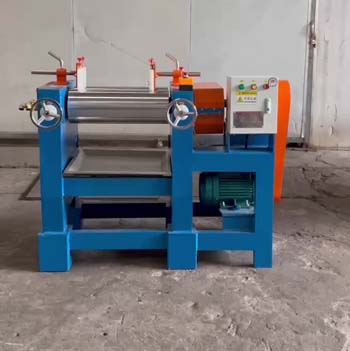In the world of plastic processing, Polyvinyl Chloride as short of PVC ,it is versatile and widely used plastic material. To prepare PVC for molding, extrusion, or further compounding, it must first be evenly blended with additives such as stabilizers, plasticizers, and colorants. A laboratory mixing mill machine is an essential equipment mainly used to process PVC material .
In this article ,let us explores how a laboratory mixing mill works for PVC material ? And why two roll mill equipment plays a critical role in research, quality control, and small-batch formulation.
What is a Laboratory Mixing Mill?
A laboratory mixing mill is also known as two-roll mill ,it is a compact version of industrial open mixing mills. The two roll mill features two horizontally counter-rotating cylindrical rollers, rotating at different speeds in opposite direction ,so that create a strong shearing and blending force on the PVC material and mix the mixture evenly.
Typically ,these two rollers are typically made from alloy chilled cast iron or forged steel material ,they are heated or cooled through oil or electric heating way.
How Does It Work for PVC?
1. Preheating and Feeding
Before PVC resin and additives are fed into the two roll laboratory mixing mill equipment, the two rollers are usually heated to a specific temperature (usually between 120–170°C) ,the temperature degree depend on the specific material and formulation. Once the rollers reach the temperature as desired , then some PVC material is manually fed on to the gap between these two roller .
2. Shearing and Compounding
As these two rollers rotating, they pull the PVC material into the nip (the space or gap between the rollers) . Thr roller apply pressure and shear onto the PVC material,which are blended,dispersed and mixed uniformly throughout the polymer matrix by this mechanical shear action.
With the rollers rotating ,the friction and pressure also generate little heat, which is good to soften the PVC material, and also it accelerate the material to be melt with plasticizers or stabilizers. Due to the different speed between the two roller , which ensures proper stretching and folding of the compound material, thus greatly improve the homogeneity of compound material.
3. Thickness Control
Generally , the operators can adjust the roller gap to control the thickness of raw material, so that form the desired PVC sheet material. Basically ,thinner gaps between rollers can increase their shearing force, thus promote better mixing for the compound material. On the other hand, wider gaps would create stiffer compounds material easily.
4. Cutting and Collection
When the final material are formed to the desired consistency and dispersion as desired and come out from the mixing mill equipment, the compound material can be cut into sheets using a knife or collected manually. These formed sheets can then be tested as formulationi for physical properties, thermal behavior, and color consistency in the lab.
Why Chose Mixing Mill for PVC Process?
* Additive Dispersion: This mill equipment ensures even distribution of heat stabilizers, plasticizers, and pigments within the PVC resin.
* Fusion Testing: Checks how well PVC resin fuses with additives at a given temperature and shear rate.
* Sample Preparation: Produces testable samples for quality inspection or R&D purposes.
* Formula Development: With these lab mixing mill ,it can help to develope and optimize new PVC formulations before scaling up to industrial mixers or extruders.
Advantages of Using a Laboratory Mixing Mill for PVC
* Precise Temperature and Gap Control
* Fine adjustments enable accurate simulation of industrial conditions for reproducible results.
* Small Batch Capability
* Ideal for testing new formulas without wasting large quantities of material.
* Enhanced Observation
In conclusion , the two roll mill is a powerful and indispensable lab mixing equipment for PVC material processing.
From blending raw PVC with additives to preparing quality control samples, this laboratory mixing mill helps engineers and chemists gain full control over the compound’s performance and consistency. Whether you are in product development or academic research, with one laboratory mixing mill equipment surely improve your PVC processing outcomes.







